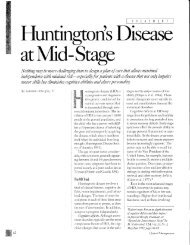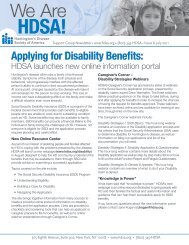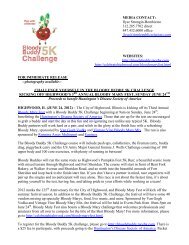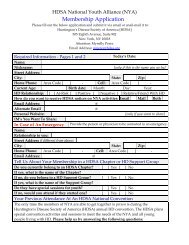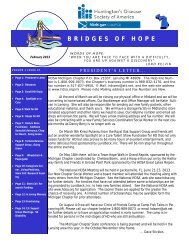Understanding Behavior in HD.final.8-18-05 - Huntington's Disease ...
Understanding Behavior in HD.final.8-18-05 - Huntington's Disease ...
Understanding Behavior in HD.final.8-18-05 - Huntington's Disease ...
You also want an ePaper? Increase the reach of your titles
YUMPU automatically turns print PDFs into web optimized ePapers that Google loves.
36<br />
Many chronically ill patients hide multiple medication bottles “<strong>in</strong> case I need them” all over the house,<br />
apartment or room. An occasional unobtrusive check while the person with <strong>HD</strong> is bath<strong>in</strong>g or eat<strong>in</strong>g may be<br />
wise. It is not only suicide that is problematic but a decision such as “I’m not right today—I need to take a few<br />
of those pills.”<br />
ANXIETY<br />
DEFINITION<br />
It is common for an <strong>in</strong>dividual with any chronic progressive illness to experience some excess anxiety, or<br />
worries, about the future. Oftentimes, however, symptoms of anxiety can become so severe that they are<br />
problematic. Anxiety can present <strong>in</strong> a variety of ways, <strong>in</strong>clud<strong>in</strong>g general nervousness, restlessness, repetitive<br />
thoughts about troublesome topics, fidget<strong>in</strong>g hands, shallow breath<strong>in</strong>g, sweat<strong>in</strong>g, rapid heart rate, fear or panic.<br />
Typically, anxiety symptoms are worse when <strong>in</strong>dividuals are <strong>in</strong> new situations or perceive themselves to have<br />
<strong>in</strong>sufficient skill to handle a situation. Often, anxiety is associated with depression. Many <strong>in</strong>dividuals with <strong>HD</strong><br />
f<strong>in</strong>d that they worry more than they used to. Even about seem<strong>in</strong>gly trivial matters, excess worry occurs. For<br />
<strong>in</strong>stance, several patients have reported that the day prior to a doctor’s appo<strong>in</strong>tment is particularly anxietyridden.<br />
When anxiety symptoms become severe, other anxiety disorders can be present, such as panic disorder or<br />
obsessive-compulsive disorder. Panic disorder is characterized by an acute onset of overwhelm<strong>in</strong>g anxiety and<br />
feel<strong>in</strong>gs of dread often accompanied by rapid heart rate, sweat<strong>in</strong>g, hyperventilation, light-headedness or<br />
numbness and t<strong>in</strong>gl<strong>in</strong>g of f<strong>in</strong>gers and toes. The symptoms typically last about 15 m<strong>in</strong>utes, but residual anxiety<br />
often rema<strong>in</strong>s. Obsessive-compulsive disorder is characterized by senseless recurrent <strong>in</strong>trusive thoughts or<br />
impulses (obsessions) that are anxiety-provok<strong>in</strong>g. Compulsions are repetitive behaviors that are performed over<br />
and over, sometimes <strong>in</strong> response to an obsession or as part of a stereotyped rout<strong>in</strong>e that must be followed. The<br />
most common obsessions tend to focus on cleanl<strong>in</strong>ess (such as wash<strong>in</strong>g hands) or safety (such as check<strong>in</strong>g to<br />
make sure the stove is turned off). Although true panic and obsessive-compulsive disorders are rare <strong>in</strong> <strong>HD</strong>, they<br />
can occur. More common are components of these anxiety disorders, such as obsessive preoccupation with<br />
particular ideas.<br />
STRATEGIES TO AVOID ANXIETY<br />
• Establish rout<strong>in</strong>es and stick to them.<br />
• Keep the environment simple.<br />
• Keep demands simple (one step at a time).<br />
• Refra<strong>in</strong> from discuss<strong>in</strong>g future stressful events until the day before.<br />
• Plan on changes <strong>in</strong> rout<strong>in</strong>e and compensate for these stressful times.




